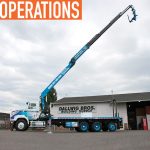A 1990’s advertising campaign declaring, “You have a lot riding on your tires,” demonstrated the importance the safe operation (specifically of tires) of a vehicle is to any family. Today, most fleet operations understand that they, too, have a lot riding on their tires. The safety of workers and the general public, customer service, public relations, and just plain being able to get the job done often relies on the safe and efficient use of company vehicles. In many businesses, nothing would get done without a viable fleet of vehicles.
FLEET OPERATIONS
For many years, fleet operations were seen as a secondary operation to many organizations. Construction companies that ran fleets of literally hundreds of trucks could not see themselves as the trucking company that they were because it was outside of their focus on building and fixing things. The same was true of many other industries that rely heavily on transportation, including plumbing supply companies, steel fabricators, food wholesalers, social service agencies, and appliance retailers. The costs associated with fleets for these organizations were seen as a necessary evil with little consideration given to efficiency or risk exposure. This began to change as the cost of vehicles and fuel escalated precipitously and costs associated with vehicle crashes skyrocketed.
Fleet operations are now looked at as a potentially huge risk exposure, as well as possibly one of the largest competitive advantages to many well run organizations. The cost of a vehicle crash can include damage to your vehicle, an injury to your driver, payments to the other party involved, negative publicity, and huge amounts of management resources. Injuries associated with vehicle crashes are the most expensive type of workers’ compensation claims in the United States according to NCCI. A million dollar auto liability claim is no longer considered a shock loss as plaintiff attorneys have become much more sophisticated and claimants often see vehicle crashes as a way to earn money.
BEST PRACTICES
To reduce the exposure of vehicle operations, fleet managers are now embracing best practices that were used by only a small fraction of operations even 10 years ago when the first fleet safety standard—the ANSI Z15: Safe Standard for Motor Vehicle Operations—was initially published. Now, drivers of company vehicles for mostly larger fleets are closely screened at the time of hire. Today, vehicles are electronically tracked and new hires are trained to safely operate their vehicles and know what to do when an accident occurs. While these safety concepts may seem evident by today’s standards, it was quite different in a previous era when operations managers were focused on production and cost reduction.

DOWN TO THE DRIVER
The most critical aspect of any fleet safety program is the driver. People choose to be safe and do not change their safety habits when they get to work. Identifying at-risk drivers begins with a review of their motor vehicle records (MVRs), discussing previous crashes they have been involved in, and giving them a road test. Just because an individual has been driving for five years at work without a reported accident does not mean that they are a safe driver. How many near misses have they had? And, many younger drivers today have never driven a vehicle larger than a compact car. Their previous history and capacity to operate the type of vehicle they will use at work is an excellent barometer of the risk exposure that they pose. It is important to have objective safety standards in place for new drivers and that existing drivers
ABOUT THE AUTHORS:
Steve Bojan, VP of fleet risk services for Hub International, has 20 years of operations and risk management experience in the transportation industry and serves as a resource for brokerage operations with transportation related risks, providing risk control, safety, property, environmental, and workers compensation reduction guidance. His specialties include transportation risk management, driver and supervisor training, truckload operations, DOT compliance, safety program development, and specialty fleet operations, including moving and non-emergency medical transportation.
Phil Casto, senior VP for risk services at HUB International, has extensive experience in the construction, manufacturing, and petrochemical industries. He serves as a resource for the insurance brokerage operations, providing solutions in the areas of risk mitigation, safety, regulatory compliance, and workers compensation.
_______________________________________________________________________
MODERN WORKTRUCK SOLUTIONS: MAY 2016 ISSUE
Did you enjoy this article?
Subscribe to the FREE Digital Edition of Modern WorkTruck Solutions magazine.
![]()




